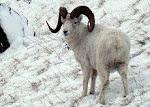Friday, April 29, 2011
Spring Swans
The Swans have returned to Alaska. Usually one of the first of the migratory wwaterfowl to return to the north country and the last to leave in the fall. This nesting pair was photographed at Beluga Lake in Homer, Alaska. They will be interesting to watch during the spring and summer season, it appears that they will remain on the lake. While watching them, I had the opportunity to watch them go through the mating ritual as well as move into the grassland, I am assuming to build a nest.
The next sequence of shots was taken of the "Cob" (Male) following the mating process with his mate. The female Swan is called a "Pen".
Monday, April 25, 2011
The "Grand Slam" 2010
I consider myself very fortunate to have photographed each of the four species of Wild Sheep that inhabit North America during the Calendar Year of 2010. The largest population of wild sheep that I had the opportunity to view was the Rocky Mountain Big Horn. I spent many hours in British Columbia, Montana, South Dakota, Wyoming, and Colorado observing these beautiful animals.
The most elusive specie that I had the most difficulty in photographing were the Desert Big Horns, I had the opportunity to see a number of these species in Arizona and Nevada. Although, I was not able to get in close to get the photographs I wanted, I did have the opportunity to witness seven Rams grouped up just prior to the rut. I will return to photograph each of these species, but in particular the Desert Ram, now that I know their habits and the terrain that they prefer.
Dall Sheep ~ Turnagain Arm, Alaska
Stone Sheep (Ram) ~ Toad River, Yukon Territory
Rocky Mountain Big Horn ~ Black Hills, South Dakota
Desert Big Horn ~ Dyer, Nevada
Saturday, April 16, 2011
Spring time In Alaska
Spring is slowly evolving in Alaska. In the next forty-five days, the cycle of life once again transpires as new life explores the world in which they live. It is amazing to watch their growth rate, how rapidly they learn to survive in a harsh environment, yet still have a natural curiosity about their surroundings and what they will encounter. Within a couple of years, they two will give birth to new life, thus the cycle goes unbroken.
"Sniffing The Rhubarb"
"Snacking On Lupine Blossoms"
"Curiosity"
"Tastes Good"
Saturday, April 2, 2011
Head Shots
Being an avid rifle hunter for many years, I thoroughly enjoyed the stalking of the game in order to get within close range. When my interest in photography commenced I applied the same technique in getting in close to get detailed shots of the animal that I was stalking. Not having the range of a high powered rifle with my camera, I learned the most important aspect of stalking game animals. Patience, by taking your time and be willing to hold in one spot for a long period of time. Patience will not only provide you some good shots, it also gives you an opportunity to learn more about the animal and catch some very unique poses that it will present to you.
In the photography of wildlife, likely the most important thing that I learned from experienced personnel with Halo Bay Bear Viewing, was the approach and your silhouette. Putting what I learned while photographing Brown Bear, I used the same technique on all of the other species with great success. When standing, your silhouette is not only easily seen but it is also intimidating to the animal. Combine this with spending several minutes rigging a tripod, by the time you are ready to shoot, the subject is nervous and will move away from you. At a minimum, remain kneeled at all times; it is even better to sit down until your shooting is complete. If you are photographing with others, approach the wildlife, single file, one person directly behind the other. This is also less intimidating to the wildlife.
This series of photographs are all head shots, primarily I was wanting to capture the eyes and facial expressions of the animal.
Calf Moose ~ Anchor Point, Alaska
American Bald Eagle ~ Homer, Alaska
Moose Calf ~ Anchor Point, Alaska
Brown Bear ~ Hallo Bay, Alaska Peninsula
American Bald Eagle ~ Anchor Point, Alaska
Rocky Mountain Big Horn Sheep ~ Black Hills, South Dakota
Rocky Mountain Big Horn ~ Black Hills, South Dakota
Rocky Mountain Big Horn ~ Black Hills, South Dakota
Rocky Mountain Big Horn ~ Black Hills, South Dakota
Bison ~ Yukon Territory, Canada
Dall Ram ~ Turnagain Arm, Alaska
Winter Moose Feeding ~ Anchor Point, Alaska
Pronghorn Antelope ~ Wyoming
Rocky Mountain Big Horn Ewe and Lamb ~ Montana
Rocky Mountain Big Horn Ewe ~ Montana
Subscribe to:
Posts (Atom)








